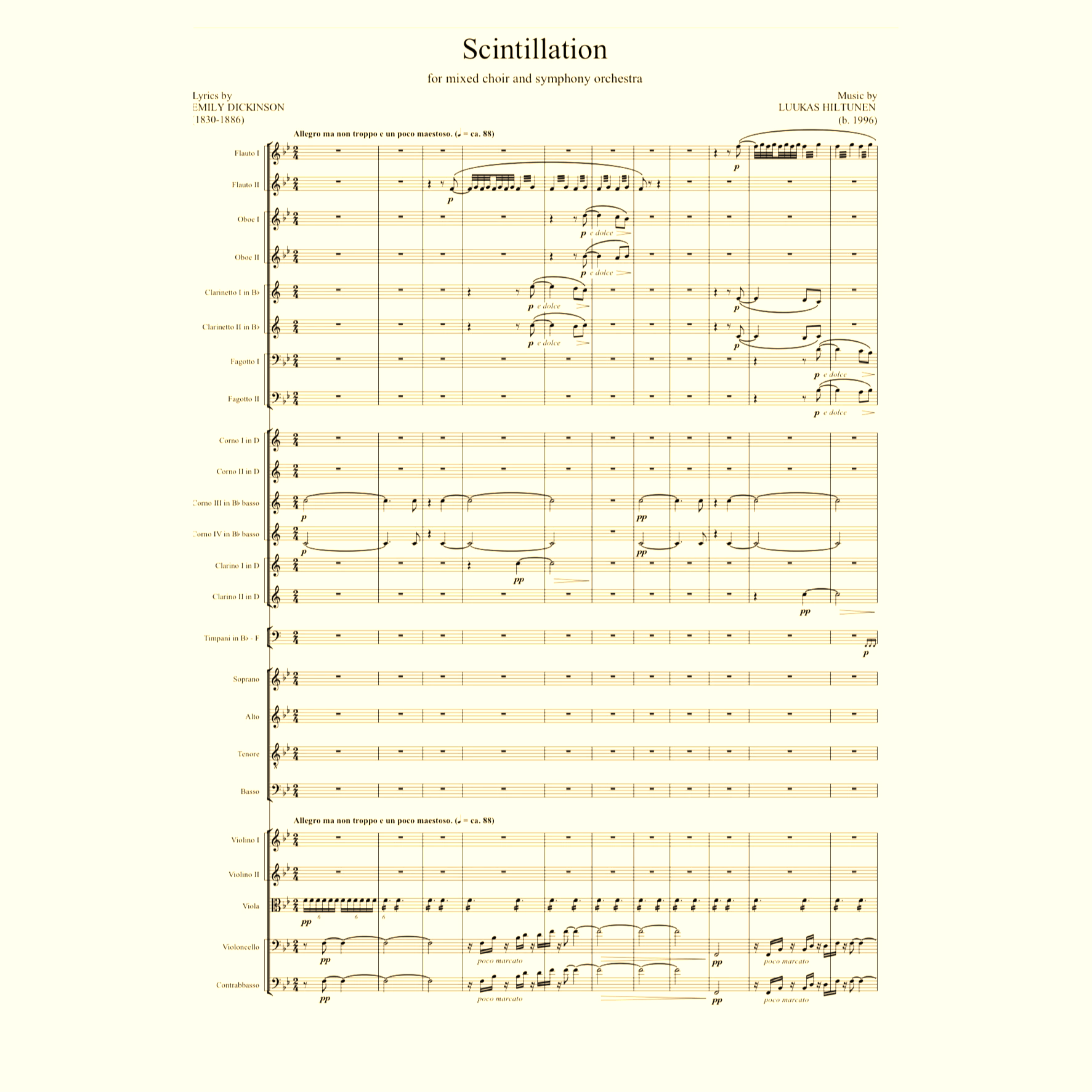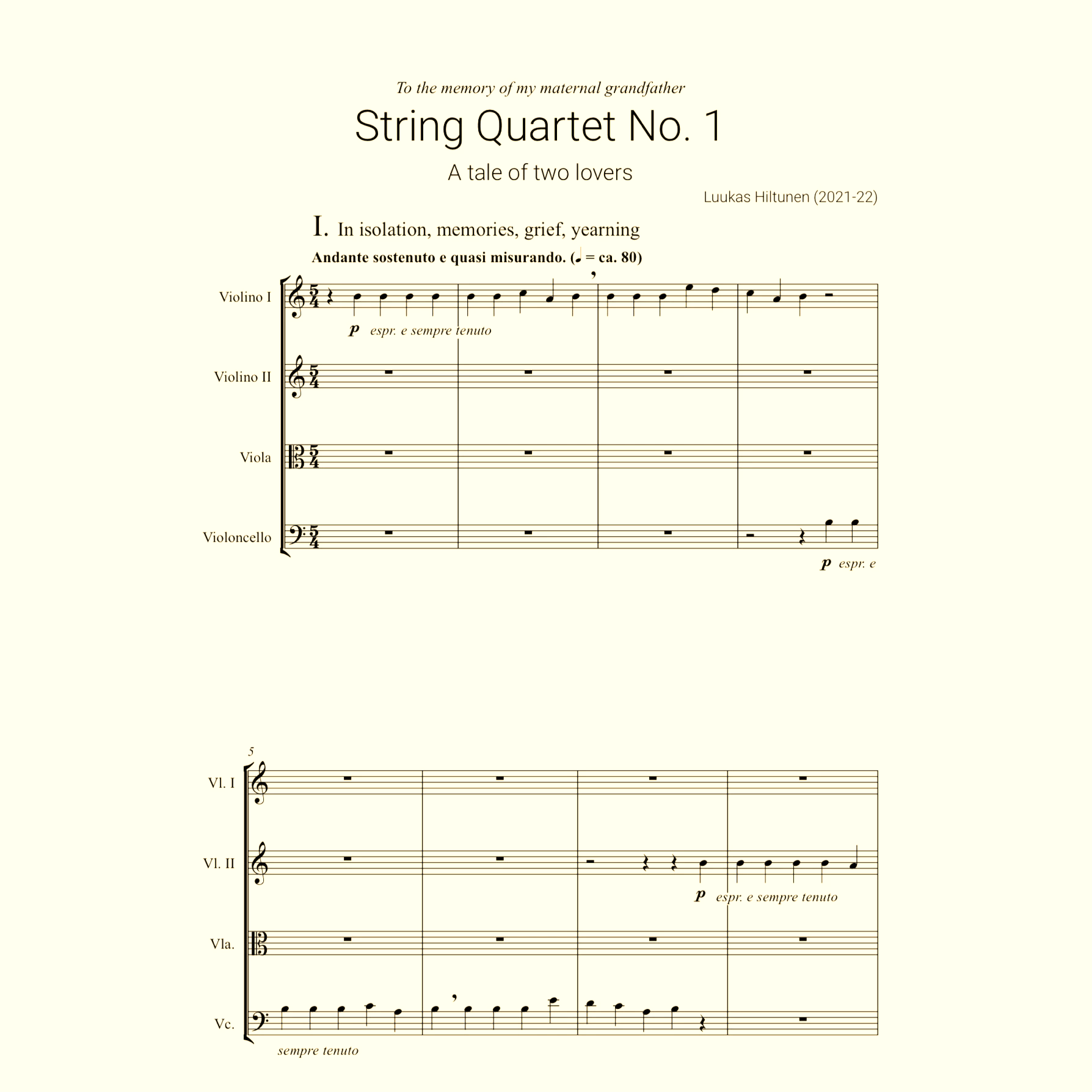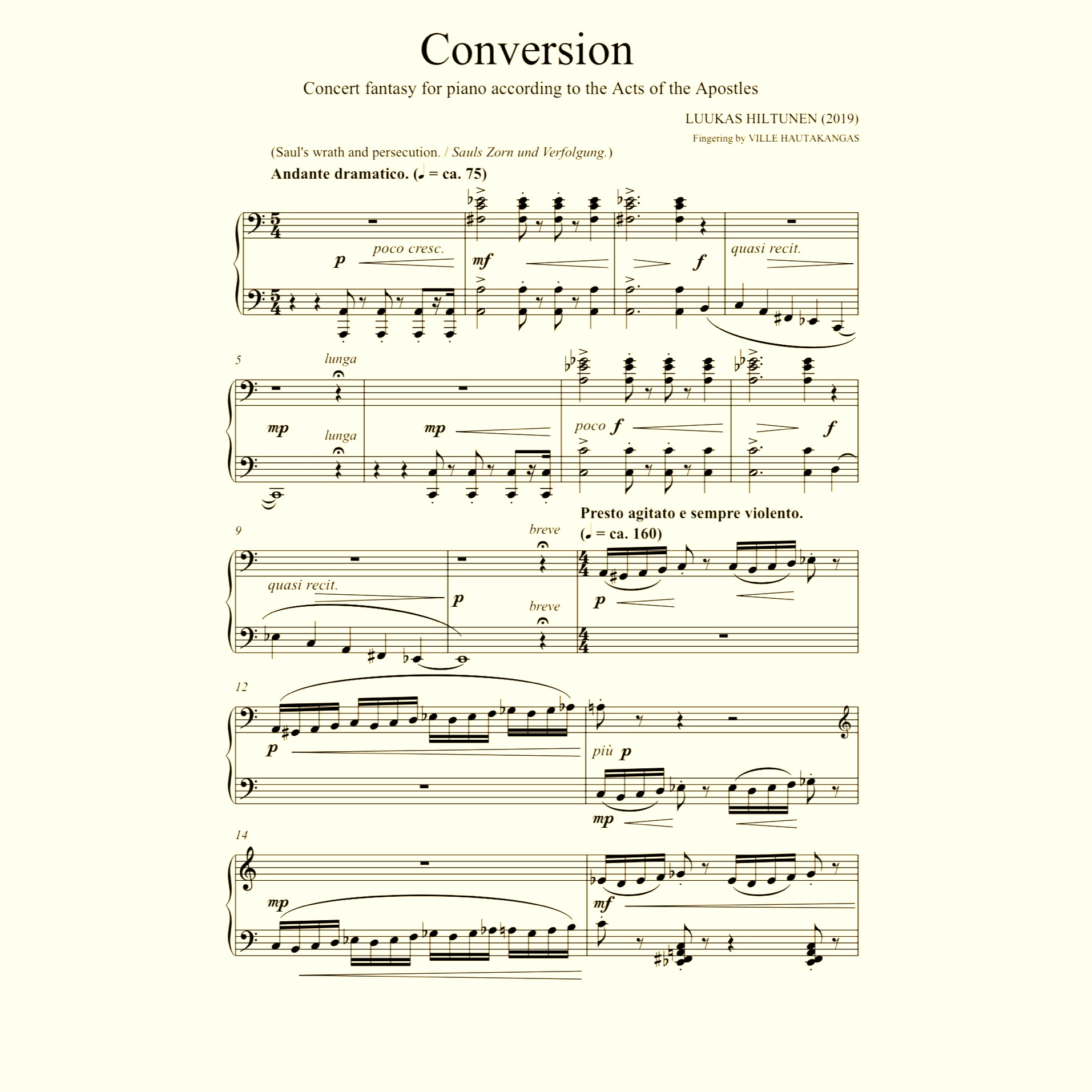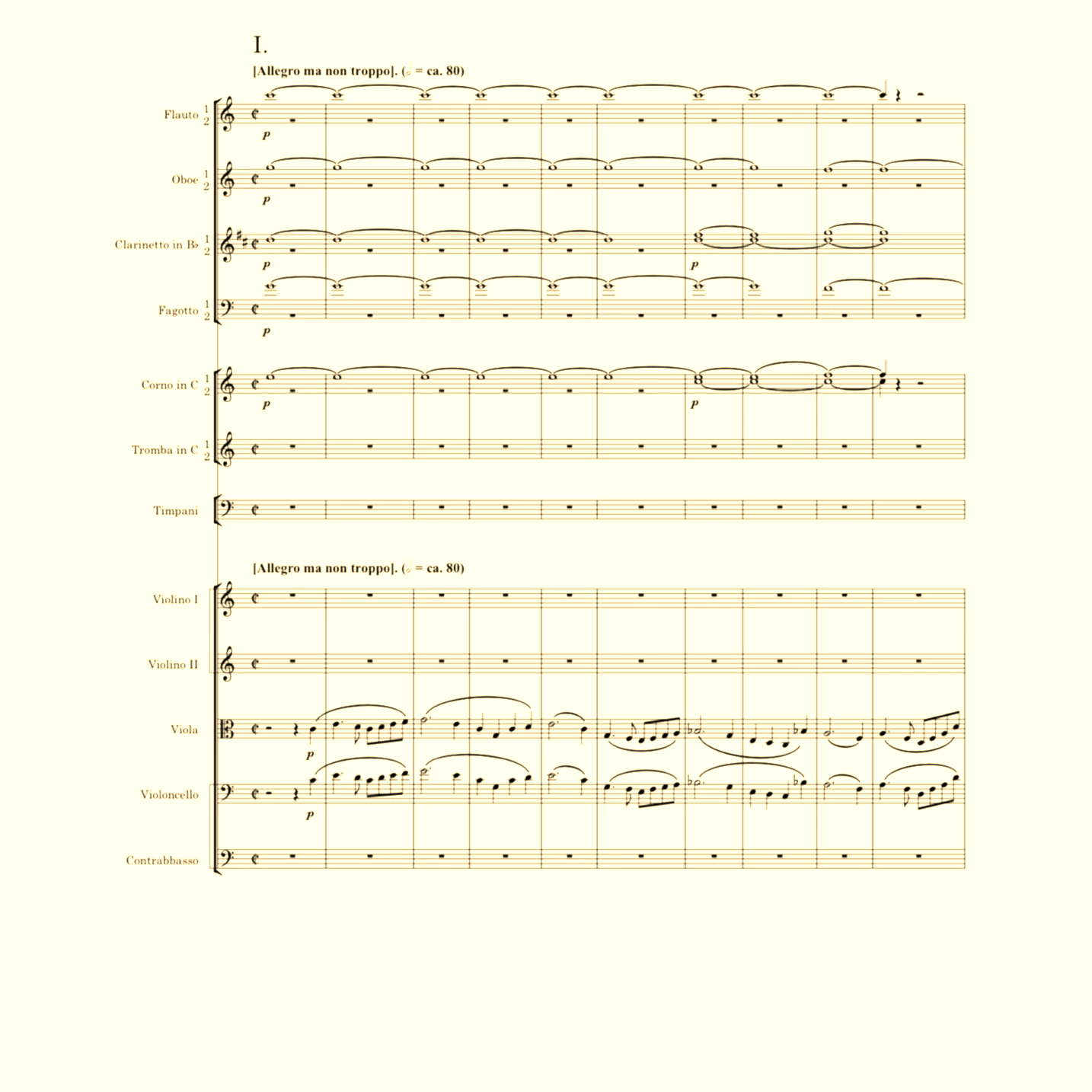Selected works

“Scintillation” — orchestral (2024)
for mixed choir and symphony orchestra (10’)
Allegro ma non troppo e un poco maestoso
Text: Hope is the thing with feathers by Emily Dickinson (c.1861)
• Commissioned by Mikkeli Music Festival for its 33rd opening concert on August 3, 2024
• Composed as an uninterrupted introduction to Ludwig van Beethoven’s Symphony No. 9 in D minor, Op. 125 (1824) to commemorate the 200th anniversary of the symphony’s existence
• Premiered on August 3, 2024, at Martti Talvela Hall, Mikaeli Concert and Congress Centre, Mikkeli, by Helsinki Philharmonic Choir, Saimaa Sinfonietta and Orkester Norden under the baton of Aliisa Neige Barrière
Scintillation (2024) is a radiant choral-orchestral work that sets Emily Dickinson's iconic poem Hope is the thing with feathers in a musical language at once tender and luminous. Commissioned for the opening concert of the 2024 Mikkeli Music Festival, the piece reflects Hiltunen's deep affinity for tonal clarity and emotional immediacy, bridging Romantic lyricism with contemporary harmonic color.
Dickinson's compact yet soaring meditation on hope — as an ever-singing bird that "perches in the soul" — resonates powerfully in Hiltunen's setting. The composer treats the text not only with reverence, but also with a sense of wonder, allowing the music to breathe and shimmer in response to each poetic image. The title Scintillation evokes flickering light and ethereal movement, suggesting both inner illumination and the elusive presence of hope itself.
The orchestral writing is spacious and textural, supporting the choir with subtle colorations rather than overwhelming force. From hushed, almost weightless beginnings, the music grows into moments of ecstatic intensity, before returning to quiet, enduring affirmation — mirroring the poem's journey from fragility to resilience.
With Scintillation, Hiltunen offers a moving and timely reflection on hope's quiet strength in uncertain times — music that uplifts not through grandeur, but through grace. Together with Beethoven’s iconic Ninth Symphony, Scintillation forms a continuous ca. 75-minute whole, preaching the feather-light hope that constantly flickers in the soul, finding its musical fulfillment in Beethoven's seminal masterpiece, reaching toward unity and oneness.

"A tale of two lovers" — chamber (2022)
"A Tale of Two Lovers"
String Quartet No. 1 (40’)
I. In isolation, memories, grief, yearning: Andante sostenuto e quasi misurando (10’) – silence for at least one minute –
II. Intermezzo: Moderato ma non tanto (6’) – attacca –
III. Romanze, Reunion: Andante cantando e molto espressivo (12’) – attacca –
IV. Finale, Return: Sostenuto e misterioso – Allegro con brio – Largamente assai (11’)
In memoriam of the composer's maternal grandfather
Premiered on November 25, 2022, at Haihara Art Centre, Tampere, by String Quartet ILME (Maria Turunen, 1st violin, Ida Hoefft, 2nd violin, Lauri Suni, viola, Eero Vahtola, violoncello)
String Quartet No. 1, subtitled A Tale of Two Lovers, is a deeply personal and emotionally charged work, completed on May 7, 2022, in memory of the composer's maternal grandfather, who had had a significant influence on Hiltunen’s early education and who had passed during the composition of the quartet’s first movement on October 4, 2021. While the subtitle nods to Shakespeare's Romeo and Juliet, the quartet is not a direct retelling, but rather a poetic reflection on love, loss, and legacy — filtered through Hiltunen's own family history and the timeless tragedy of Shakespeare's young lovers.
Structured in a single continuous arc, the four-movement work draws its emotional narrative from both personal grief and dramatic inspiration. Tender lyricism and intimate dialogue between the instruments evoke moments of youthful affection, longing, and fragility. These give way to more turbulent, dissonant passages — echoes of fate, conflict, and parting — before resolving in a coda of quiet transcendence.
Stylistically, the quartet showcases Hiltunen's characteristic blend of tonal harmony and expressive intensity, with echoes of late Romanticism shaped by a distinctly contemporary voice. The music balances introspection with theatrical flair, inviting listeners into a space where memory and myth coexist.
In A Tale of Two Lovers, Hiltunen transforms personal mourning into a universal meditation on love's enduring power — even in the face of inevitable separation which will only find its ultimate fulfillment in eternity.

"Conversion" — instrumental (2019)
Concert Fantasy for Solo Piano (15’)
Andante dramatico – Presto agitato e sempre violento – Andante dramatico – Presto agitato e sempre violento – Andante mosso
Inspired by the Acts of the Apostles: The Conversion of Saul (Acts 9:1–19)
Premiered on November 28, 2022, at Small Auditorium, Tampere Hall, by Ville Hautakangas
Conversion (2019) is a vivid and dramatic concert fantasy for solo piano that explores one of the most powerful spiritual turning points in Western religious tradition — the conversion of Saul of Tarsus on the road to Damascus, as recounted in the Acts of the Apostles. Rather than offering a strictly programmatic retelling of the biblical narrative, Hiltunen crafts a psychologically and spiritually charged journey that evokes inner conflict, divine confrontation, and ultimate transformation.
The piece is structured as a single-movement fantasy, marked by intense contrasts in texture, rhythm, and harmonic color. It begins with aggressive, almost violent gestures, evoking Saul's zealous persecution of early followers of the Way. Thunderous chords and rapid figuration reflect his relentless momentum and inner unrest. As the music unfolds, these storm-like passages give way to sudden silences and moments of suspended time, representing the divine interruption — a radiant light from heaven and the voice of Christ that strikes Saul down and blinds him.
Hiltunen captures this moment of rupture not only with dynamic extremes but through a shift in musical language. Dissonance softens into ambiguity; harmonic chaos is gradually replaced by translucent textures, suggesting the dawning of spiritual awareness. The middle section of the work is marked by introspection, fragility, and searching melodies, as Saul — now blind and vulnerable — is led to Damascus, both physically and spiritually disoriented.
The final portion of the fantasy depicts the revelation and rebirth of Saul as Paul. The music becomes increasingly luminous and exultant, yet retains an undertone of humility and awe. Virtuosic flourishes return, but now transformed — they no longer drive the narrative through force, but lift it toward transcendence. The closing pages shimmer with restrained triumph, suggesting a soul awakened to grace and irrevocably changed.
Conversion is not only a testament to Hiltunen's narrative sensitivity and pianistic imagination but also to his ability to navigate spiritual themes with emotional authenticity. The work stands as a compelling exploration of inner upheaval and renewal — where sound becomes a vessel for the sacred and the personal becomes universal.

"Symphony No. 6 in C major" — a reconstruction (2023)
Felix Mendelssohn Bartholdy (1809–1847): Symphony No. 6 in C major (1842–46)
Realised and reconstructed by Luukas Hiltunen (2023) after sketches housed at the Bodleian Libraries, University of Oxford (25’)
I. Allegro ma non troppo (15’)
II. Andante (10’)
Commissioned by the Gewandhausorchester Leipzig
Premiered on October 24, 2024, at Vaasa City Hall, by Vaasa and Seinäjoki City Orchestras under the baton of James Sherlock
Felix Mendelssohn Bartholdy’s Symphony No. 6 in C major occupies a fascinating place in the composer's creative legacy — not as a finished masterpiece, but as an intriguing fragment from the final years of his life. Left incomplete at the time of his death on November 4, 1847, the symphony existed only in sketch form, with varying degrees of completeness across its first two movements. These surviving materials, now housed in the Bodleian Libraries at Oxford University, provide a tantalizing glimpse into what might have been another major symphonic statement from one of the 19th century's most gifted composers.
In 2023, Finnish composer and musicologist Luukas Hiltunen undertook the ambitious task of realizing and reconstructing this unfinished work, following a commission by the Gewandhausorchester Leipzig — the very orchestra Mendelssohn once led as Kapellmeister. Hiltunen's approach to the reconstruction is grounded in careful scholarly study of Mendelssohn's autograph materials, stylistic practices, and compositional procedures, while also drawing upon his own intuitive understanding of Mendelssohn's mature voice.
The reconstruction results in a two-movement symphonic torso, consisting of a fully realised Allegro ma non troppo in C major and a contrasting Andante in G major. The first movement, derived from the most complete of Mendelssohn's sketches, displays the composer's hallmark clarity of form, buoyant rhythmic drive, and elegant orchestration — qualities reminiscent of the Italian Symphony (No. 4), but with a more muscular, Beethovenian energy. Hiltunen has filled in structural and harmonic gaps with discretion, aiming to remain faithful to Mendelssohn's musical idiom without imposing excessive modern interpretation.
The second movement, based on more fragmentary sketches, is an evocative and lyrical Andante, constructed in a way that reflects the inward-facing tone found in Mendelssohn's late chamber music and sacred works. Here, Hiltunen had to make more substantial compositional decisions, particularly in terms of voice leading, transitions, and instrumentation, always with a view to honoring Mendelssohn's poetic restraint and formal elegance.
Rather than attempting to fabricate a full four-movement symphony out of incomplete material, Hiltunen chose to preserve the fragmentary nature of the project, presenting a two-movement form that offers a compelling and respectful insight into Mendelssohn's late style. The result is not a pastiche, but a historically informed and musically sensitive act of completion — a bridge between the past and present that reanimates the spirit of a work long left in silence.
This reconstruction is both a scholarly achievement and a deeply musical creation, allowing today's audiences to hear, for the first time, a substantial realization of Mendelssohn's final symphonic thoughts — brought to life with precision, humility, and reverence.